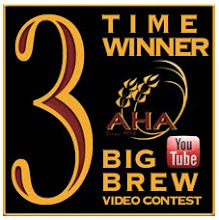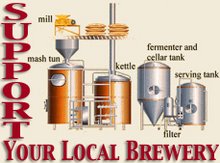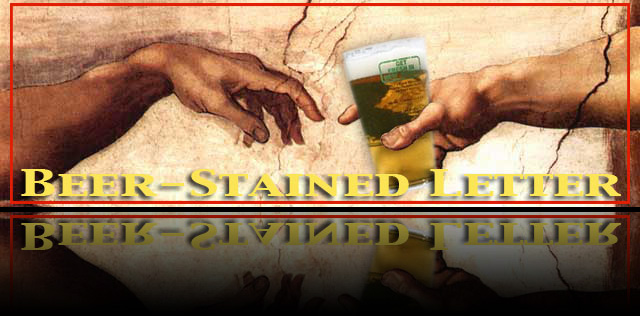 Flying Fish hit a milestone this week, brewing a 5,000th batch of beer – a chocolate stout that will mark the sixth stop (Exit 13) in its well-received Exit Series of brews.
Flying Fish hit a milestone this week, brewing a 5,000th batch of beer – a chocolate stout that will mark the sixth stop (Exit 13) in its well-received Exit Series of brews.
Since brewing began in August/September 1996, thousands of barrels of beer have been kegged or bottled and sent out the doors of the Cherry Hill brewery to markets in Delaware; Maryland; Pennsylvania; Washington, DC; and of course New Jersey.
A few brewers have come and gone during those 14 brewing years, while current (and longtime) brewer Casey Hughes is a well-known face of Flying Fish to many people. Also in that decade and a half, FF has picked up some national recognition for its Belgian-style beers, high honors for its Exit 4 American Trippel and Abbey Dubbel.
To mark the occasion of the 5,000th batch, it seemed fitting to track down the brewer who helped launch the brand that founder Gene Muller conceived as a "virtual microbrewery" on the Web in 1995 and grew into New Jersey's largest craft beer name at 12,000 barrels annually.
 Joe Pedicini, a Berkeley Heights native, came to Flying Fish in spring 1996 from Deschutes Brewery in Bend, Oregon, and joined by assistant brewer Rick Atkins, struck the first mashes that would become the extra pale ale and extra special bitter with which FF entered the marketplace. (That's Joe at left with his 18-month-old daughter, Una.)
Joe Pedicini, a Berkeley Heights native, came to Flying Fish in spring 1996 from Deschutes Brewery in Bend, Oregon, and joined by assistant brewer Rick Atkins, struck the first mashes that would become the extra pale ale and extra special bitter with which FF entered the marketplace. (That's Joe at left with his 18-month-old daughter, Una.)
A quite tasty porter, the Abbey Dubbel, a Belgian farmhouse ale and Hopfish IPA would round out the lineup during Joe's two-year stint at FF. The porter, bottle-conditioned back in the early days, was phased out several years ago, then brought back as a winter seasonal imperial espresso porter. While the recipes – chiefly the hops used – have changed for the XPA and ESB, those beers are stilll cornerstones of Flying Fish's beer offerings and were among the brews legendary beer writer/explorer Michael Jackson sampled during a brewery visit when FF's beermaking operations were a mere six months old (see top photo; that's Joe on the left, Gene Muller at right).
Now calling Brooklyn home, Joe has turned his zymurgist's attention to winemaking, an interest he developed from both his family heritage (from Italy's southwest coast) and spending some of his post-FF days working for New York auction houses, connecting buyers to rare wines.
 For his own label, Montebruno, Joe produces small-batch artisanal Pinot noir, using Oregon grapes grown organically and sustainably. His first commercial batch of Oregon Pinot noir was bottled in 2003, and these days he spends a lot of time shuttling between the Willamette Valley and New York. On the heels of bottling some vintage 2009 in Oregon, Joe took some time last week for a Q&A, reminiscing a little bit about Flying Fish and discussing Montebruno Wines.
For his own label, Montebruno, Joe produces small-batch artisanal Pinot noir, using Oregon grapes grown organically and sustainably. His first commercial batch of Oregon Pinot noir was bottled in 2003, and these days he spends a lot of time shuttling between the Willamette Valley and New York. On the heels of bottling some vintage 2009 in Oregon, Joe took some time last week for a Q&A, reminiscing a little bit about Flying Fish and discussing Montebruno Wines.
BSL: Where did you come up with the name Montebruno?
JP: Montebruno is a tribute my grandmother on my mother's side; it's her maiden name.
BSL: Wine is in your heritage. Your father made wine, right?
JP: On my father's side, the region where they emigrated to the States from is called Campania. They all had vineyards and made wine. It was just an ordinary-life kind of thing; they didn't own a private-label winery, but they'd grow grapes and make wine for themselves and sell grapes to a local cooperative.
BSL: Talk a little about how you chose Oregon vineyards.
JP: I sort of researched places in the country, other than Napa Valley and California, places that would be interesting to grow (grapes) and make wine that would be unique. At first, my research took me to the Finger Lakes in upstate New York. Then I considered going back and visiting some of the family vineyards in Campania, and then I realized that I have this beautiful network of friends and now family in Oregon.
 So I said to myself, I really love Pinot noir and I have roots in Oregon because of how much time I spent out there. So I started looking back in that direction and managed to find these great sites I've been working with, and took my production from 50 cases in 2003 (pausing briefly) I just got back a few weeks ago from Oregon where I bottled 850 cases of 2009.
So I said to myself, I really love Pinot noir and I have roots in Oregon because of how much time I spent out there. So I started looking back in that direction and managed to find these great sites I've been working with, and took my production from 50 cases in 2003 (pausing briefly) I just got back a few weeks ago from Oregon where I bottled 850 cases of 2009.
BSL: Your focus on wine is not that far from the approach of craft beer, as far as scale goes, it seems.
JP: It's kind of along the lines, if you can compare it in the beer world, it's very much a hand-crafted, small-production process. Just about every aspect is done by hand.
 BSL: With the grapes themselves, you're actually inspecting and hand-selecting what gets used?
BSL: With the grapes themselves, you're actually inspecting and hand-selecting what gets used?
JP: Absolutely. I have several vineyards that I lease. There are blocks within these vineyards that are exclusively used for my label.
All the fruit that I source is grown sustainably, bio-dynamically or organically. I'm a huge supporter of that, and it's a big movement in Oregon right now. The approach isn't supposed to end at the farming of the fruit once it's in the winery. Everything that I do is done in a very Old World, sort of bio-dynamic approach where there's no additives, there's no preservatives. There's no means of doing anything funny to extract something that isn't there naturally in the grape. It's really just a pure expression of the fruit that was sourced from a beautiful, beautiful site in Oregon.
BSL: Can you talk about the uniqueness of wine as it relates to its place of origin?
JP: In the wine world, the interesting thing about it is, there is a sense of place in what you're making. You have this fruit you harvest from a place, and you turn it into wine, and there is a sense of identity where that fruit came from and there's no other wine that can taste exactly like it.
BSL: Let's turn our attention to beer. You still have an appreciation for great beer ...
JP: Oh, God yeah.
BSL: What are some of the really good beers that you think are on the landscape now?
JP: There are so many great producers. I would hate to be specific and leave anybody out. It's really more about the mood I'm in. Sometimes I still love a properly poured draft Guinness, and I still love a nice hoppy (pauses) There's a brewery here called Sixpoint that makes a Bengali IPA that's really nice. They are successfully growing in a market that was dominated by Brooklyn Brewery for so many years.
It's amazing when we think back to just a few years ago how different the landscape was with beer and how lucky we are right now. There's just so many great producers now, so many great choices.
BSL: Do you still have occasion to brew, either at home or commercially?
JP: I still brew at home. My brother-in-law has a nice little set-up at his apartment. Actually yesterday we brewed what's going to be a cask bitter ...
BSL: What do you think of the explosion of hops, all these different varieties of hops?
JP: It really seems, especially out West, they're just trying to make these IPAs bigger and bigger and hoppier and hoppier. They're kind of hard for me to drink. I think they're a little bit out of balance. I look forward to the day when things come back to reality a little bit.
BSL: Let's talk about Flying Fish. You might be surprised to see just how big the brewing and packaging space has become. What do you recall from the start-up days?
JP: I met Gene at the microbrewers conference up in Boston in '96. When he decided to hire me, that space was empty. It was just offices in the front and a big warehouse in the back. The conference was in March, and during that summer we just started bringing equipment in and setting it all up. I always appreciated the fact that Gene just totally trusted my decisions, as far as formulations and procedures of the brewery and how to run things there. I looked at it like it was my own brewery.
BSL: Talk a little about getting the brewhouse going and working out the bugs.
JP: The first time we fired up the system (to test it), there was a little bit of a glitch in the grain handling process. We ended up leaving behind a certain portion of the grist that was supposed to go into the mash tun back in the hopper and we weren't aware of it. When we took our initial gravities, they were way lower than we anticipated. That was the hop angel. The second batch, we made a pretty successful XPA. We wanted to do a large-scale batch using the yeast strain we chose; we wanted to make sure it met the profile we were looking for.
BSL: Flying Fish has grabbed some acclaim of late with the Exit Series beers themed to the Turnpike exit identity often associated with Garden State residents. Have you had occasion to try any of the Exit Series beers?
JP: You know, I have not. I've seen them and I think it's a cool marketing concept, and I'm really happy they're still doing some great experimentation. I think one of them was a (Belgian) Trippel, wasn't it?
BSL: They called it American Trippel. It was a gold medal winner last year at the Great American Beer Festival.
JP: They won a gold last year? Oh, that's awesome.
BSL: The Abbey Dubbel won silver the year before.
JP: That's awesome.
 BSL: Beer Hunter Michael Jackson made more than one visit to Flying Fish, but you were there for his first tour of the brewery and sampling of beers back in March 1997.
BSL: Beer Hunter Michael Jackson made more than one visit to Flying Fish, but you were there for his first tour of the brewery and sampling of beers back in March 1997.
JP: He was very complimentary; he really liked the ESB. He said 'Man I could put down a few pints of that.' I thought that was a good compliment. It was a nice reward, coming from the standpoint of, here we are, we have this new product and new brewery, we're putting in massive hours, and we're really busting our asses, and then he comes by, tastes the beers and he likes 'em, and it makes you feel good about all the effort.
BSL: Finally, what's next for you in the wine world, where do you take Montebruno?
JP: There's lots of cool vineyard sites becoming accessible, and we're sort of assessing that and we're hoping to maybe get a 10- or 15-acre property that we can call our own.




















